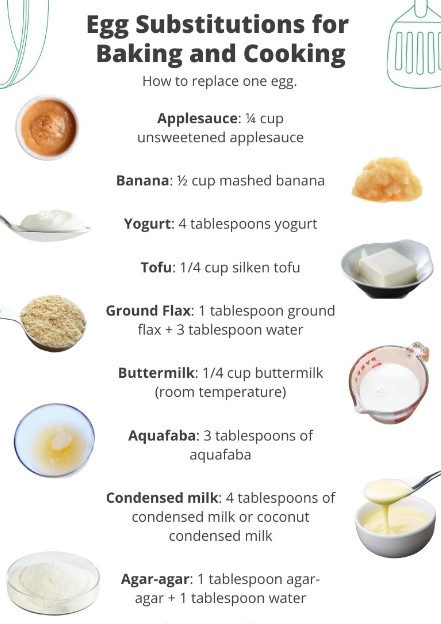BOURSESSENEGAL – When it comes to baking and cooking, finding the right egg substitute can be a game changer. Whether you’re dealing with allergies, dietary preferences, or simply running out of eggs, knowing your options will help you maintain the taste and texture of your dishes. In this guide, we’ll explore various egg substitute, their uses, and how to choose the right one for your recipes.
What is an Egg Substitute?
An egg substitute replaces eggs in a recipe. People often seek egg substitute for several reasons, such as vegan diets, allergies, or health concerns. The goal is to replicate the binding and leavening properties of eggs while maintaining flavor and texture. Different substitutes work better in different types of dishes, so it’s crucial to understand your options.
Why Use an Egg Substitute?
Using an egg substitute can benefit those with dietary restrictions, allergies, or lifestyle choices. Here are some common reasons:
- Vegan Diet: Vegans avoid animal products, including eggs.
- Allergies: Some individuals have egg allergies and need alternatives.
- Health Concerns: Reducing cholesterol or calorie intake might prompt some to look for substitutes.
- Availability: Sometimes, you simply run out of eggs!
Popular Egg Substitute
Let’s dive into some popular egg substitute, their measurements, and best uses in cooking and baking.
1. Applesauce
Measurement: Use 1/4 cup of unsweetened applesauce to replace one egg.
Applesauce works well in baked goods, adding moisture and a hint of sweetness. It’s perfect for muffins, cakes, and brownies. However, avoid using it in recipes that rely heavily on the egg for structure, such as soufflés.
2. Flaxseed Meal
Measurement: Mix 1 tablespoon of flaxseed meal with 2.5 tablespoons of water. Let it sit for 5-10 minutes until it becomes gelatinous.
Flaxseed meal serves as a great binding agent and is rich in omega-3 fatty acids. Use it in cookies, pancakes, and breads for a nutty flavor. Keep in mind that flaxseed has a distinct taste, so it might not suit all recipes.
3. Chia Seeds
Measurement: Similar to flaxseeds, combine 1 tablespoon of chia seeds with 2.5 tablespoons of water and let it sit.
Chia seeds create a gel-like consistency that works well as a binder. They’re fantastic in smoothies, energy bars, and baked goods. Plus, they add fiber and nutrients to your recipes.
4. Silken Tofu
Measurement: Use 1/4 cup of blended silken tofu to replace one egg.
Silken tofu is an excellent substitute for adding moisture and creaminess. It’s ideal for cakes, brownies, and puddings. Be cautious, as it can alter the flavor slightly, so it’s best used in savory dishes or rich desserts.
5. Yogurt
Measurement: Use 1/4 cup of plain yogurt to replace one egg.
Yogurt adds moisture and tanginess, making it a suitable option for pancakes, muffins, and cakes. It also helps keep baked goods tender. Non-dairy yogurt can be used for vegan recipes.
6. Commercial Egg Replacers
These products are designed specifically to replace eggs in recipes. Follow the package instructions for the correct measurements. They typically consist of starches and other ingredients that mimic the binding and leavening properties of eggs.
Choosing the Right Egg Substitute
Selecting the right egg substitute depends on the recipe and your personal preferences. Here are some factors to consider:
Type of Dish
- Baked Goods: Applesauce, flaxseed, and chia seeds work well.
- Savory Dishes: Silken tofu or yogurt can provide the right texture.
- Custards or Sauces: Consider using commercial egg replacers for a similar mouthfeel.
Flavor Considerations
Some substitutes add their own flavors, like flaxseed or applesauce. For neutral-flavored dishes, opt for substitutes that won’t alter the overall taste.
Texture Requirements
In recipes where eggs provide structure, such as soufflés or meringues, it’s challenging to find a perfect substitute. You might need to experiment with different options to achieve the desired texture.
Tips for Using Egg Substitute
- Test in Small Batches: When trying a new substitute, test it in a small batch before committing to a full recipe.
- Adjust Baking Times: Some substitutes might change baking times, so keep an eye on your dishes while they cook.
- Combine Substitutes: In some cases, you can combine substitutes for better results. For example, using both applesauce and baking powder can provide moisture and leavening.
- Follow the Recipe: When substituting, stick closely to the measurements to ensure consistency.
Conclusion
Using an egg substitute doesn’t have to be daunting. With various options available, you can find a suitable replacement for your cooking and baking needs. Whether you choose applesauce, flaxseed meal, or commercial egg replacers, understanding how each substitute works will help you create delicious dishes without eggs. So next time you find yourself out of eggs, don’t fret—grab one of these substitutes and continue on your culinary journey! Happy cooking!
REFERENCE : pepesislot



